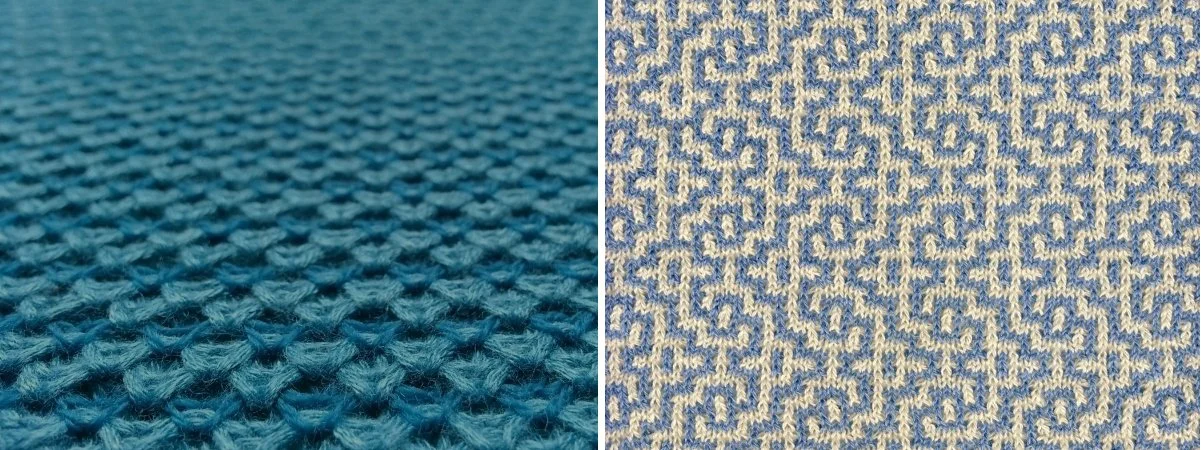A Good Tuck
Ah, the tuck stitch! You gotta love it. Seriously. We machine knitters only have four basic "stitches" (knit, purl, tuck, and miss). Two of them are actually the same stitch (knit and purl) seen from opposite sides. One of them (the miss, a.k.a slip or skip) isn't really a stitch, though knitting a stitch when you meant to miss the stitch would make a huge difference in most projects.
That leaves the tuck. It’s a versatile stitch that can add dimension when combined with a number of techniques.
Fabrics made with tuck stitches are typically wider and shorter. Knitting tuck loops on a needle over several rows will create added depth. With different color feeds, they can be a great way to hide and reveal colors.
How does it work? When the carriage passes over a needle selected to tuck, the working yarn is placed in the hook of the needle. The needle doesn’t lift high enough for the preexisting stitch on the needle to slip behind the latch. The old stitch doesn’t knit off the needle, so both the stitch and the new yarn (the tuck) remain in the hook. (See the green tuck loop in the center of this animation on YouTube.)
Tucks with Ribs
Combining tucks with ribs is a great way to add even more depth to a rib. Tucks can also add surprising details, like pops of color peeking through, as with the swatch at the top of this page, a two-color cardigan stitch variation knitted on the Kniterate.
Tucks combined with plating add depth to the rib structure in the stitch pattern above. The tuck is an awesome master of disguise. Because the loop sits on the needle without being pulled through the previous stitch, the yarn is essentially hidden or tucked away. My tuck class for the Kniterate presents both of these tuck rib patterns, as well as the basic “rules” of tuck stitches and how they can be used to create advanced patterns.
Jersey Tucks
The jersey and tuck combination is not straightforward on the Kniterate, since knits and tucks cannot be knitted on the same bed in the same carriage pass. There is no rule against making tucks on the opposite bed, however, and then transferring them to the knitting bed.
Tucking on an empty needle will not validate in the Kniterate design app. But since a knit stitch on an empty needle will appear as a tuck loop, tucks can be placed on an empty needle by painting a knit stitch. (Think of a double bed cast-on row. The zigzag first row is really made up of tucks.) Transfer the “tucks” to the knitting bed with the next carriage traverse and you've got tucks and knits on the same bed. It's important to make the stitch size for the loop that will be transferred as small as possible for best results. The third class in my course series for the Kniterate covers tucks. Though the class focuses on rib tuck structures (where the Kniterate excels) this workaround for jersey tucks is also provided.
With other knitting machines incorporating tucks in a jersey is quite common. On a single bed, you can use tucks to create pictures in relief, for color work, or to create textures. The example below left shows an offset repeat in tonal colors, knitted on a Passap DM80 (though it could be knitted on a Kniterate with the method described in the previous paragraph). With single bed fabrics, you can see that it’s often the reverse or purl side where the tuck loop really shows.
Mosaic Knitting
Mosaic knitting can be made with tucks or miss stitches. The swatch above right is a tucked mosaic. It’s a fascinating technique because the drawn or punched pattern looks nothing like the fabric. The swatch is and example of how tucks can be combined with striping to create maze-like designs. This stitch pattern could not be knitted on a Kniterate, but a similar looking swatch could be knitted using the miss stitch method.
Tucks with Racking
The swatch below illustrates racking with tucks. Knitted on a Kniterate, racking in stitch pattern development is a technique I plan to present in a future class. A fair bit denser than previous samples, it demonstrates the potential of using racking with tucks to create small, textured stitch repeats.
O!
If you’re a Kniterate user, you may be interested in my prerecorded Designing with Kniterate classes. (Session 3 focuses on tucks!) If you’re not an owner yet, I’d be happy to give you a virtual tour of the machine.





